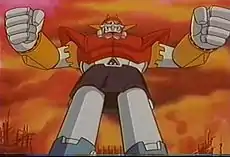UFO Warrior Dai Apolon
UFO Warrior Daiapolon (UFO戦士ダイアポロン, Yūfō Senshi Dai Aporon) was a Japanese anime series aired from 1976 in Japan. There were 47 episodes aired at 25 minutes each. It is also known as "UFO Senshi Dai-Apolon", "UFO Soldier Dai-Apolon", "UFO Robo Dai-Apolon", "Daiapolon", "Shadow World".
| UFO Warrior Daiapolon | |
 Screenshot from UFO Warrior Daiapolon | |
| UFO 戦士ダイアポロン (Yūfō senshi daiaporon) | |
|---|---|
| Genre | Mecha |
| Anime television series | |
| Directed by | Tatsuo Ono |
| Written by | Chikara Matsumoto Noboru Shiroyama Seiji Matsuoka Sōji Yoshikawa Takao Koyama |
| Studio | Eiken |
| Original network | TBS (part 1) Tokyo 12 Channel (part 2) |
| Original run | April 6, 1976 – February 24, 1977 |
| Episodes | 47 |
Original story
The story is about a 16-year-old boy Takeshi who recently formed an American football team at the Blue Sky orphanage. One day the game is interrupted by a light in the sky. Takeshi discovers he is the son of the king of the planet Apolon, spirited away to Earth by his father's retainer Labi to avoid death at the hands of General Dazaan. He turns out to have special energy abilities which can control UFO saucers from a base under the ocean floor. His friends Miki, Matsuo and Goro also become pilots. They magically change into their uniforms every time they yell U! F! O!. There are three robots: Header (Head); Trangur (Trunk) and Legger (Leg). They combine into a larger and powerful robot called Daiapolon. Through a solar-powered process known as "body fusion", activated by the "Key Energy" device placed inside the boy's chest, Takeshi can "grow" in mass and become a giant humanoid, thus "wearing" the Daiapolon as a kind of cybernetical armour. The robot resembles an American Football player.
Concept
The story adds American football into the setting backdrop as an element. Though the original concept is derived from manga Galactic Warrior Apolon by creator Tetsu Kariya (which also created the manga Oishinbo) and illustrator Shigeru Tsuchiyama (serialized in Weekly Shonen King, which also serialized the first run of the Galaxy Express 999 manga). That manga featured a 15-year-old orphan called Akira. Although there are UFO scenes in the manga, it did not have the American football or super robot elements, and the enemies were demons with the power of the 108 Stars of Destiny.[1] It was unusual for the football element to be added, since the sport was barely even recognized as an amateur sport in Japan in the mid 1970s. It may just be a coincidental blend to add variety to the super robot genre. The robot also carries a football-shaped blade.
English release
Five episodes were combined and dubbed in English to create a re-edited movie called Shadow World. The setting was changed to California and the names of the protagonists were changed to American ones, although Dai Apolon and some of the villains kept their names. This movie was released on video in 1986.
Voice actors
Original
- Narrator
Osamu Ichikawa - Takeshi
Akira Murayama - Goro
Keisuke Yamashita - Miki
Kazue Komiya - Matsuo
Sachiko Chijimatsu - Hideki
Kiyoshi Komiyama - Principal
Miyoko Shoji - Giraniku
Shōzō Iizuka
English
- Richard Rossner - Terry
- Marla Scott - Mickey, Josephine
- Mona Marshall - Mark
- Gregg Berger - Grey
- Bunker Jenkins - Emperor Dazan
- Paul Ross - Garano
- Robert A. Gaston - Harold
- Laura Mendoza - Ms. Johnson
- and John Mayer as "Largo"
- Uncredited
- John Mayer - Narrator
Staff
- Screenwriter
Takao Koyama
Okihara Matsumoto
Noboru Shiroyama
Soji Yoshikawa
Seiji Matsuoka - Creator
Tetsu Kariya - Design
Toyoo Ashida - Animation
Keijiro Kimura
Takashi Kakuta
Konio Okoto
Toyoo Ashida - Music
Masahisa Takeichi
Trivia
- The show was aired Tuesday 7:00 p.m. to 7:30 p.m.
- "Apolon" has also been spelled "Apollon" interchangeably.
- The show aired at a time when major changes were occurring at TBS and halfway through the series the channels changed and what remained of DaiApolon is sometimes known as DaiApolon 2.
References
- Clements, Jonathan; McCarthy, Helen (2006). The Anime Encyclopedia: Revised & Expanded Edition. Berkeley, CA: Stone Bridge Press. ISBN 978-1-933330-10-5
External links
- Super Robot info
- Detailed review of the English language release
- UFO Senshi Daiapolon (anime) at Anime News Network's encyclopedia
- UFO Senshi Daiapolon II (anime) at Anime News Network's encyclopedia